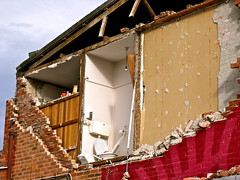
Search
Images for Damaged; more images...
Damaged
Images, eqnz.chch.2010
Awaiting restoration, the Cathedral was damaged in a series of major earthquakes. 52 in 2018: 30. Ruin or Archaelogical site
House damage
Images, eqnz.chch.2010
Typical of many homes in Kaiapoi still to be demolished and rebuit.
Earthquake Damage.
Images, eqnz.chch.2010
Damage from the Christchurch earthquake that hit on 4/9/10 @ 4:35am. Measured 7.1 on the richter scale.
Earthquake Damage.
Images, eqnz.chch.2010
Damage from the Christchurch earthquake that hit on 4/9/10 @ 4:35am. Measured 7.1 on the richter scale.
earthquake damage
Images, eqnz.chch.2010
Damage from the Christchurch 7.1 earthquake on 4th Sept 2010
Earthquake Damage.
Images, eqnz.chch.2010
Damage from the Christchurch earthquake that hit on 4/9/10 @ 4:35am. Measured 7.1 on the richter scale.
earthquake damage
Images, eqnz.chch.2010
Damage from the Christchurch 7.1 earthquake on 4th Sept 2010
earthquake damage
Images, eqnz.chch.2010
Damage from the Christchurch 7.1 earthquake on 4th Sept 2010
earthquake damage
Images, eqnz.chch.2010
Damage from the Christchurch 7.1 earthquake on 4th Sept 2010 Church of St. John the Baptist, Latimer Square, Christchurch, New Zealand
earthquake damage
Images, eqnz.chch.2010
Damage from the Christchurch 7.1 earthquake on 4th Sept 2010
Earthquake Damage
Images, eqnz.chch.2010
2010-4232 Christchurch earthquake 7.1M 4 Sep 10
earthquake damage
Images, eqnz.chch.2010
Damage from the Christchurch 7.1 earthquake on 4th Sept 2010
Church damage
Images, eqnz.chch.2010
None
Quake Damage
Images, eqnz.chch.2010
When I lived in Christchurch back in 2004-2005, this was a building I went past on the bus every day to get to and from work in the city. After the big quake on 04/09/10 (7.1 magnitude), its been seriously damaged. As have many more of the shops in this area. Thankfully no lives were lost in the quake, and I'm glad I wasnt there to feel it eith...
Lyttelton earthquake damage
Images, eqnz.chch.2010
None
Lyttelton Empire Hotel Quake Damage
Images, eqnz.chch.2010
None
Ruth Gardner's Blog 05/09/2010: Doleful Damage
Articles, UC QuakeStudies
An entry from Ruth Gardner's blog for 5 September 2010 entitled, "Doleful Damage".
Lyttelton Cemetery earthquake damage
Images, eqnz.chch.2010
None
probable earthquake damage 1b
Images, eqnz.chch.2010
deduced from the fact the breaks appeared new and others damaged around it.
probable earthquake damage 1a
Images, eqnz.chch.2010
deduced from the fact the breaks appeared new and others damaged around it.
An Earthquake Damaged Cliff Top Home
Images, UC QuakeStudies
Damage to a wooden house at the top of a cliff.
Quake Damaged churches
Audio, Radio New Zealand
We are taking a look at some of Christchurch's icon and heritage buildings lost, or at least badly damaged by last Tuesdays earthquake.
Kaiapoi, earthquake damage
Images, eqnz.chch.2010
Damage from the Christchurch 7.1 earthquake on 4th Sept 2010
Christchurch Cathedral Damage
Images, eqnz.chch.2010
None
Christchurch Cathedral Damage
Images, eqnz.chch.2010
None
Christchurch Cathedral Damage
Images, eqnz.chch.2010
None
Christchurch, NZ - Damaged Facade
Images, eqnz.chch.2010
None
Quake damage - how were the land damage assessments made?
Audio, Radio New Zealand
Nick Rogers, project director, Canterbury Land Assessment for Tonkin & Taylor. Tonkin & Taylor is the environmental and engineering consultancy doing the Canterbury land damage assessment work for EQC and the Canterbury Earthquake Recovery Authority.
Building pounding damage observed in the 2011 Christchurch earthquake
Research papers, University of Canterbury Library
This paper describes the pounding damage sustained by buildings in the February 2011 Christchurch earthquake. Approximately 6% of buildings in Christchurch CBD were observed to have suffered some form of serious pounding damage. Typical and exceptional examples of building pounding damage are presented and discussed. Almost all building pounding damage occurred in unreinforced masonry buildings, highlighting their vulnerability to this phenomenon. Modern buildings were found to be vulnerable to pounding damage where overly stiff and strong ‘flashing’ components were installed in existing building separations. Soil variability is identified as a key aspect that amplifies the relative movement of buildings, and hence increases the likelihood of pounding damage. Building pounding damage is compared to the predicted critical pounding weaknesses that have been identified in previous analytical research.
Building pounding damage observed in the 2011 Christchurch earthquake
Research papers, University of Canterbury Library
This paper describes the pounding damage sustained by buildings in the February 2011 Christchurch earthquake. Approximately 6% of buildings in Christchurch CBD were observed to have suffered some form of serious pounding damage. Typical and exceptional examples of building pounding damage are presented and discussed. Almost all building pounding damage occurred in unreinforced masonry buildings, highlighting their vulnerability to this phenomenon. Modern buildings were found to be vulnerable to pounding damage where overly stiff and strong ‘flashing’ components were installed in existing building separations. Soil variability is identified as a key aspect that amplifies the relative movement of buildings, and hence increases the likelihood of pounding damage. Building pounding damage is compared to the predicted critical pounding weaknesses that have been identified in previous analytical research.



